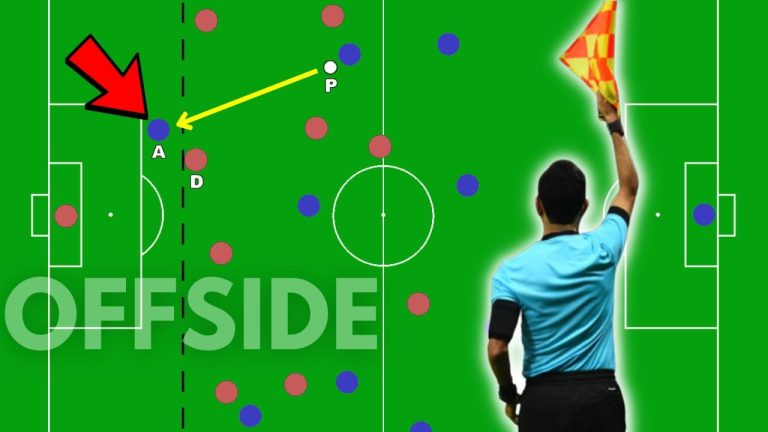Offside position in soccer is a crucial yet often misunderstood aspect of the game. It is a rule designed to maintain fairness and prevent players from gaining an unfair advantage by positioning themselves closer to the opponent’s goal line. Whether it’s a perfectly timed run or a split-second decision by the referee, understanding the intricacies of offside position can make or break a team’s attacking strategy. In this article, we delve into the fundamentals of offside position, the impact it has on gameplay, and how it continues to spark debates among fans and experts alike.
What does offside position mean in football?
Offside position in football refers to the position of a player on the field relative to the opposing team’s goal line. To be considered offside, any part of the player’s head, body, or feet must be closer to the opponents’ goal line than both the ball and the second-last opponent. Additionally, the player must be in the opponents’ half of the field, excluding the halfway line. This rule is crucial in maintaining fair play and preventing players from gaining an unfair advantage by being in an advantageous position during attacking plays.
Being in an offside position can have significant implications for a player’s involvement in the game. If a player is deemed to be offside, they are not allowed to participate in active play until they rectify their position. This means they cannot receive the ball directly from a teammate or be involved in any goal-scoring opportunities. The offside rule aims to ensure that players maintain a fair distance from the opponents’ goal line, promoting fair competition and preventing players from gaining an unfair advantage.
Understanding the concept of offside position is essential for both players and fans of football. By adhering to this rule, the game becomes more disciplined, strategic, and fair. It adds an element of challenge for attacking players, as they must time their movements carefully to stay onside and contribute effectively to their team’s attack. This rule fosters a balance between offense and defense, making the game more exciting and engrossing for all involved.
What does the offside rule mean in soccer?
The offside rule in soccer is a crucial aspect of the game that ensures fair play and prevents unfair advantages. According to the law, a player is considered offside if any part of their body, excluding the hands and arms, is positioned in the opponents’ half of the pitch, and closer to the opponents’ goal line than both the ball and the second-last opponent. This rule aims to maintain balance and discourage players from gaining an unfair advantage by strategically positioning themselves closer to the goal.
By enforcing the offside rule, soccer promotes a level playing field and strategic gameplay. It prevents players from lurking near the opponents’ goal, waiting for a pass that would give them an advantageous position. Instead, players must time their movements carefully, ensuring they are not in an offside position when the ball is played to them. This rule encourages teamwork, strategic positioning, and skilled decision-making, enhancing the overall excitement and fairness of the game.
Understanding the offside rule can be challenging for both players and spectators, but it adds an extra layer of excitement and strategic thinking to the game. The rule not only maintains fairness but also rewards players who display excellent timing and awareness. Additionally, it adds suspense and anticipation, as fans eagerly watch to see if a player will be caught offside or make a well-timed run that leads to a goal-scoring opportunity. Overall, the offside rule is a fundamental aspect of soccer that enhances the sport’s tactical nature and keeps the game exciting for all involved.
What is a specific instance that illustrates the concept of offside?
Offside occurs in sports, such as soccer, when an attacker hinders an opponent’s ability to play the ball. This interference can take various forms, such as blocking the goalkeeper or obstructing their line of vision. When an attacker prevents the opponent from participating or impairs their sight, they are considered offside.
In soccer, offside is a rule that highlights the importance of fair play and equal opportunities for both teams. An example of offside is when an attacker interferes with an opponent by either impeding their ability to play or preventing them from participating in the game. This can be seen when a player obstructs the goalkeeper’s line of vision, making it difficult for them to react to the ball. By enforcing the offside rule, soccer ensures that players respect the balance between offense and defense, promoting a fair and competitive environment.
Demystifying Offside: Unraveling the Soccer Conundrum
Demystifying Offside: Unraveling the Soccer Conundrum
Offside, a term often used in soccer, has perplexed both players and fans for decades. However, understanding this enigmatic rule is crucial to fully appreciating the game. In its simplest form, offside occurs when a player is nearer to the opponent’s goal line than the ball and the second-to-last defender at the moment the ball is played. It is a complex but essential aspect of the game that demands precision and strategic awareness.
The offside rule is designed to maintain fairness and prevent players from gaining an unfair advantage by lurking too close to the goal. It promotes an open and dynamic game by encouraging players to stay in active play rather than passively positioning themselves near the goal line. By restricting attackers from being ahead of the second-to-last defender, offside ensures that defenders have a fair chance to organize their defense and create a balanced playing field.
To determine offside, the referee relies on precise timing and positioning. The moment the ball is played, the referee assesses the positions of the attacking player and the second-to-last defender. If the attacker is closer to the goal line, a flag is raised, and the opposing team is awarded an indirect free-kick. This intricate rule adds an element of strategy and anticipation to the game, as players must constantly be aware of their positioning and timing to avoid falling foul of the offside trap.
In conclusion, understanding the offside rule is essential for soccer enthusiasts to fully comprehend the intricacies of the game. By maintaining fairness, promoting an open play style, and requiring precise timing and positioning, offside adds an exciting dimension to the sport. So, the next time you watch a game, keep an eye out for those razor-thin offside decisions that can make or break a team’s chances of victory.
Exploring Offside: Clearing the Air on Soccer’s Most Debated Rule
Exploring Offside: Clearing the Air on Soccer’s Most Debated Rule
In the world of soccer, few rules have sparked as much controversy and debate as the offside rule. Often misunderstood, this rule has the power to change the course of a game in an instant. Essentially, a player is considered offside if they are nearer to the opponent’s goal line than both the ball and the second-to-last defender when the ball is played to them. This rule aims to prevent goal-hanging and promote fair play, ensuring that attackers do not gain an unfair advantage. However, its interpretation and implementation have been a subject of intense scrutiny, leading to heated discussions among players, coaches, and fans alike. As the beautiful game continues to evolve, it is imperative to dissect and understand the intricacies of offside, ultimately enabling a clearer and more coherent application of this controversial rule.
The Offside Enigma: Unveiling the Secrets of Soccer’s Infamous Position
The Offside Enigma: Unveiling the Secrets of Soccer’s Infamous Position
In the world of soccer, few positions have perplexed both players and fans quite like the offside rule. With its intricate web of lines and strict timing, it remains an enigma on the field. But behind this perplexity lies a strategic game within the game, where players strive to stay one step ahead of their opponents. Mastering the art of timing and positioning, they navigate the fine line between advantage and penalty. With each well-executed offside trap or perfectly timed run, they unlock the secrets of this infamous position, leaving spectators in awe and opponents scratching their heads. The offside rule may be a puzzle, but for those who dare to unravel its mysteries, it holds the key to soccer’s most thrilling moments.
In the world of soccer, the offside position remains a critical and often debated aspect of the game. Whether it’s a close call or a clear-cut decision, players and fans alike hold their breath as they await the referee’s verdict. While some may argue that the offside rule adds complexity and frustration to the sport, it ultimately serves to maintain fairness and uphold the integrity of the game. By preventing attackers from gaining an unfair advantage, the offside position ensures that goals are scored within the boundaries of fair play, enhancing the excitement and thrill of soccer for both players and spectators.



